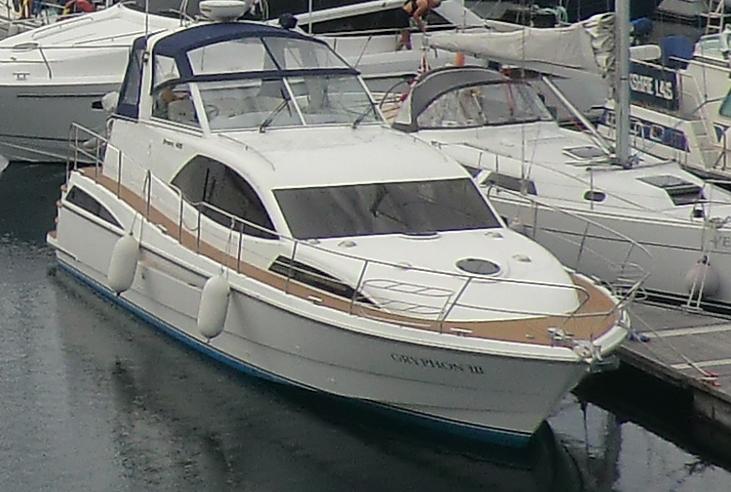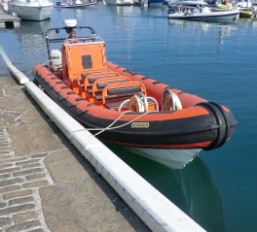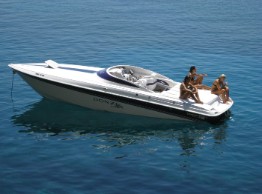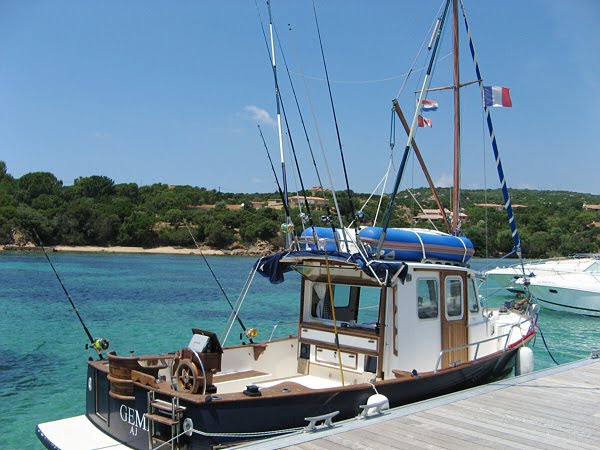POWER BOATS
Power Boat Types
Boats are mainly separated into two different types; they are wind powered and engine powered boats. Power boats can then be separated again into the following different boat types.
Luxury Cabin Cruiser The cabin cruiser is a powerboat that has accommodation and living quarters. Generally, they have bedrooms, a bathroom and a small kitchen/lounge area, as well as a deck and driving position. Some cabin cruisers have a sun roof/deck. They usually range in size from 25ft to 45ft in length. |  |
RIB (Rigid Inflatable Boat) A Rigid Inflatable Boat is a modern variation of a speed boat. It has a light weight, high performance body with a rigid hull and inflated, flexible tubes. This designs gives it a stable, high performance bass; which has a high capacity. Used by the military, RNLI and many other organisations; the RIB is not just for the recreational boater. |  |
Speed Boats Speed boats go fast; thus the name speed boat. They generally have a high power to weight ratio and a hydrodynamic hull design. This design gives them a higher top speed and improved handling; as well as minimal resistance and drag, compared to most boats. These boats are used by many for recreational water sports. |  |
Bow Rider (Speed boat) A bow rider is a variation of the speed boat and there is not much difference except it has an open bow which allows for extra seating and space for luggage and equipment. It can also act as a nice sun bed or pick-nick area. |  |
Modern Small Fishing Boat Modern fishing boats are a lot like speed boats but also a lot like original fishing boats. Their high performance, slim hull; which gives low resistance, together with its spacious deck and centre console/cockpit gives the perfect modern machine for the old sport and industry of fishing. These boats can often have built in extras like rod holders and cool boxes too! |  |
Traditional Fishing Boat Traditional fishing boats are generally slow and don’t offer much in terms of speed, seaworthiness and space. They are basic boats with often just a small cabin at the bow. |  |
Inflatable/SIB SIB stands for ‘soft inflatable boat’ and these small boats are often used by boat owners to get to boats out on moorings in the estuary. You may occasionally see them on the back of luxury cabin cruisers. They are very small and don’t need a big engine; a 1-3hp engine is usually suitable. |
OUTBOARD ENGINE CHECKS:
Pre start check out:
-
Check fuel supply
- Make sure the tank is vented
- Check fuel lines and connections
- Make sure clamps are tight (we wouldnt want the engine to fall off!)
- Lower engine to proper running position
- Engine is in neutral
- Make sure the kill cord is in
- Check steering
Fuel systems:
There are so many fuel systems and its vitally important that you check the handbook, that you should receive with your boat to understand how your system works and where the components are located.
The best systems isolate each engine with a separate fuel tank/system (if you do not have two engines, you can add an extra fuel tank to your equipment and if the exixting one fails you can swap to your added plastic one) so that failure in one will not affect the other.
In order to function properly all fuel systems need to be carefully maintained, need to be clean and air free.
Systems and Controls:
The cooling system on a boat differs from one of a car as it uses heat exchange via sea and fresh water to cool the engine rather than a radiator. This is why it is vital that you clean your engine out after each use, not doing this will result in a rusting engine with mechanical faults and problems will start to occur.
A boat cooling system contains a number of components including: sea cocks where the sea water enters the system, strainers to filter out debris, pumps to drive the sea and fresh water around, inter coolers which cool compressed air from the turbo charger, heat exchangers which let the sea water cool the closed fresh water cooling system, along with wet exhausts to remove salt water with the exhaust gases.
The fresh and sea water systems are separate and each cools different areas of the engine and gear box oils.
Launch And Recovery:
You can launch from a slipway or off some beaches, there is usually a designated area to launch from. You may have to pay a launching fee, (see the local harbour master for details) before you launch your boat you should check, oil, fuel and that all equipment (eg. gps, radio, flares) is on board and working.
This is a detailed article on how to launch and recover boats:
The order that I find easiest to launch and recover with:
(for recovery just reverse)
-
PULL on to beach and reverse until trailer is about 2ft away from the water.
-
TAKE off light and reg plate board off back.
-
TAKE off prop bag and main straps holding the boat on, (leaving just the winch strap)
-
MAKE sure all equipment is on board
-
REVERSE into water until the boat can nearly float off
-
PUSH boat off and get somebody to hold it in the water
-
PULL away and put trailer in a suitable place (i normally leave mine on the shale at the top of the beach)
-
PARK vehicle
-
HAVE A GOOD TIME!